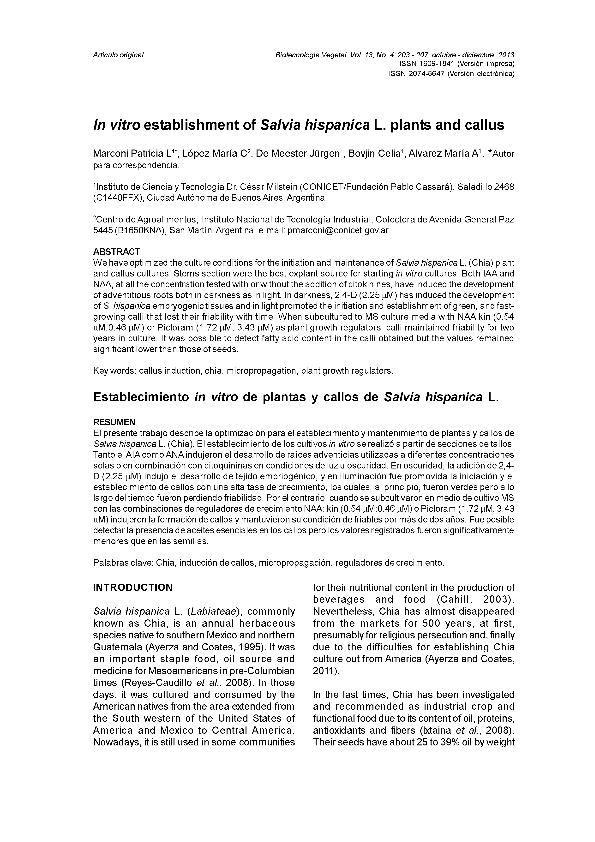Artículo
We have optimized the culture conditions for the initiation and maintenance of Salvia hispanica L. (Chia) plant and callus cultures. Stems section were the best explant source for starting in vitro cultures. Both IAA and NAA, at all the concentration tested with or without the addition of citokinines, have induced the development of adventitious roots both in darkness as in light. In darkness, 2,4-D (2.25 |iM) has induced the development of S. hispanica embryogenic tissues and in light promoted the initiation and establishment of green, and fastgrowing calli that lost their friability with time. When subcultured to MS culture media with NAA:kin (0.54 |iM:0.46 |iM) or Picloram (1.72 |iM, 3.43 |iM) as plant growth regulators, calli maintained friability for two years in culture. It was possible to detect fatty acid contení in the calli obtained but the valúes remained significant lower than those of seeds. El presente trabajo describe la optimización para el establecimiento y mantenimiento de plantas y callos de Salvia hispanica L. (Chia). El establecimiento de los cultivos in vitro se realizó a partir de secciones de tallos. Tanto el Al A como ANA indujeron el desarrollo de raíces adventicias utilizadas a diferentes concentraciones solas o en combinación con citoquininas en condiciones de luz u oscuridad. En oscuridad, la adición de 2,4- D (2.25 |iM) indujo el desarrollo de tejido embriogénico, y en iluminación fue promovida la iniciación y el establecimiento de callos con una alta tasa de crecimiento, los cuales, al principio, fueron verdes pero a lo largo del tiempo fueron perdiendo friabilidad. Por el contrario, cuando se subcultivaron en medio de cultivo MS con las combinaciones de reguladores de crecimiento NAA: kin (0.54 |iM:0.46 |iM) o Picloram (1.72 |iM, 3.43 |iM) indujeron la formación de callos y mantuvieron su condición de friables por más de dos años. Fue posible detectar la presencia de aceites esenciales en los callos pero los valores registrados fueron significativamente menores que en las semillas.
In vitro establishment of Salvia hispanica L. plants and callus
Título:
Establecimiento in vitro de plantas y callos de Salvia hispanica L.
Marconi, Patricia Laura ; López, María C.; De Meester, Jürgen; Bovjin, Celia; Alvarez, Maria Alejandra
; López, María C.; De Meester, Jürgen; Bovjin, Celia; Alvarez, Maria Alejandra
 ; López, María C.; De Meester, Jürgen; Bovjin, Celia; Alvarez, Maria Alejandra
; López, María C.; De Meester, Jürgen; Bovjin, Celia; Alvarez, Maria Alejandra
Fecha de publicación:
12/2013
Editorial:
Instituto de Biotecnología de las Plantas
Revista:
Biotecnología Vegetal
ISSN:
1609-1841
e-ISSN:
2074-8647
Idioma:
Inglés
Tipo de recurso:
Artículo publicado
Clasificación temática:
Resumen
Palabras clave:
Cultivo de Tejidos
,
Embriogenesis Somatica
,
Chia
,
Salvia Hispanica
Archivos asociados
Licencia
Identificadores
Colecciones
Articulos(ICT - MILSTEIN)
Articulos de INST.DE CS. Y TECNOLOGIA "DR. CESAR MILSTEIN"
Articulos de INST.DE CS. Y TECNOLOGIA "DR. CESAR MILSTEIN"
Citación
Marconi, Patricia Laura; López, María C.; De Meester, Jürgen; Bovjin, Celia; Alvarez, Maria Alejandra; In vitro establishment of Salvia hispanica L. plants and callus; Instituto de Biotecnología de las Plantas; Biotecnología Vegetal; 13; 4; 12-2013; 203-207
Compartir



